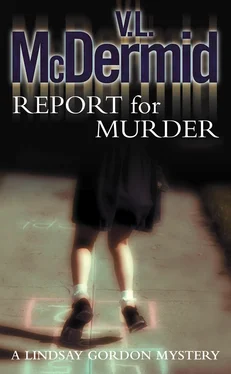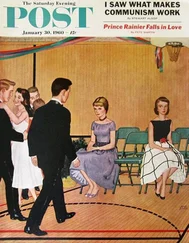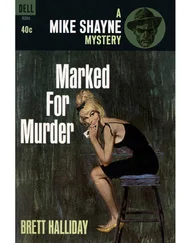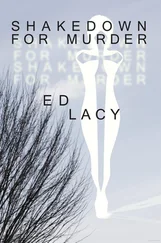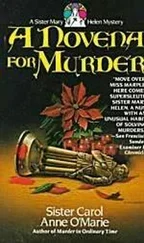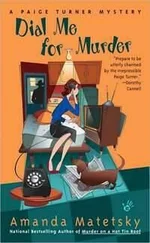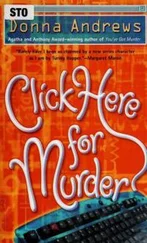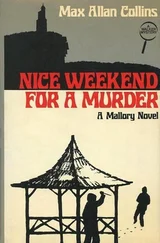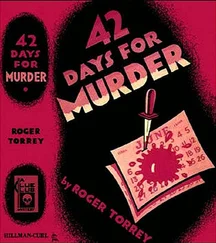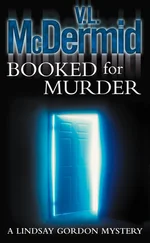V.L. McDERMID
Report for Murder
Copyright Copyright Dedication Foreword PART ONE: OVERTURE 1 2 3 4 PART TWO: EXPOSITION 5 6 7 8 9 10 11 12 PART THREE: FUGUE 13 14 15 16 PART FOUR: FINALE 17 18 19 20 21 PART FIVE: CODA 22 Keep Reading About the Author Also by the Author About the Publisher
This novel is entirely a work of fiction. The names, characters and incidents portrayed in it are the work of the author’s imagination. Any resemblance to actual persons living or dead, events or localities is entirely coincidental.
HarperCollins Publishers Ltd. 1 London Bridge Street London SE1 9GF
www.harpercollins.co.uk
First published in Great Britain by The Women’s Press Ltd 1987
Copyright © Val McDermid 1987
Val McDermid asserts the moral right to be identified as the author of this work
A catalogue copy of this book is available from the British Library
All rights reserved under International and Pan-American Copyright Conventions. By payment of the required fees, you have been granted the nonexclusive, nontransferable right to access and read the text of this ebook on-screen. No part of this text may be reproduced, transmitted, downloaded, decompiled, reverse-engineered, or stored in or introduced into any information storage and retrieval system, in any form or by any means, whether electronic or mechanical, now known or hereinafter invented, without the express written permission of HarperCollins ebooks
HarperCollins Publishers has made every reasonable effort to ensure that any picture content and written content in this ebook has been included or removed in accordance with the contractual and technological constraints in operation at the time of publication
Source ISBN: 9780007385089
Ebook Edition © OCTOBER 2010 ISBN: 9780007301775
Version: 2018-04-06
Dedication Dedication Foreword PART ONE: OVERTURE 1 2 3 4 PART TWO: EXPOSITION 5 6 7 8 9 10 11 12 PART THREE: FUGUE 13 14 15 16 PART FOUR: FINALE 17 18 19 20 21 PART FIVE: CODA 22 Keep Reading About the Author Also by the Author About the Publisher
For Gill
Cover
Title Page V.L. McDERMID Report for Murder
Copyright
Dedication
Foreword
PART ONE: OVERTURE
1
2
3
4
PART TWO: EXPOSITION
5
6
7
8
9
10
11
12
PART THREE: FUGUE
13
14
15
16
PART FOUR: FINALE
17
18
19
20
21
PART FIVE: CODA
22
Keep Reading
About the Author
Also by the Author
About the Publisher
I grew up reading mysteries. From Agatha Christie to Ruth Rendell, from Rex Stout to Chandler and Hammett, I devoured them all. But what started me working on the first Lindsay Gordon novel, Report for Murder , in the mid-1980s was the chance to march to a different drum.
There was a new wave breaking on the shores of crime fiction, and it was led by women. Even though there had never been any shortage of female protagonists in the genre, you’d have been hard pressed to find many you could call feminists. But by the early 80s, a new breed of women had emerged.
They were mostly PIs, though there were a few amateurs among them. What marked them out was their politics. Whether they called themselves feminists or not, they were strong, independent women with a brain and a sense of humour, but most of all, they had agency. They didn’t shout for male help when the going got tough. They dealt with things on their own terms.
Another key difference was that these stories were organic. They weren’t random murders bolted on to a random setting. The crimes grew out of their environment – the particular jobs people did, the lives they led, the situations and recreations they were involved in.
devoured every one of those books I could get my hands on. Sara Paretsky, Barbara Wilson, viSue Grafton, Marcia Muller, Mary Wings, Katherine V Forrest and a dozen others showed me how to write about real lives within the frame-work of murder and suspense. Their protagonists took on the male establishment when they had to, and they didn’t back down. They didn’t shy away from confronting difficult issues either.
I loved them.
I wanted to write my own version of those women. A Scottish version, a woman as firmly rooted as her American sisters, but one who would have to accommodate different laws, different customs, different politics and different histories. I didn’t have the nerve to make her a PI because I didn’t know any at the time. And I suspected women PIs in the UK would have very different professional lives to their US counterparts.
What I did know was journalism. I became a journalist after I graduated from Oxford, just to bridge the gap until I could support myself writing fiction. (I always had the absolute conviction that day would come, a conviction not shared by anyone else back then . . .) I thought if I made my character a journalist, I’d be on safe ground. I knew what journalists were capable of and how we went about circumventing the doors that were closed to us. I knew the rhythm of our working lives and what made a good newspaper story.
In other respects, Lindsay Gordon has congruences with my own background. She’s Scottish, she shares my politics, and she’s a lesbian. It would, however, be a mistake to conflate us. Our personalities are quite different. (Except that we both have a fondness for fast cars and good whisky . . .) She’s far more headstrong and stubborn than I am, for example, and much more willing to take risks.
I’m proud to say that Lindsay was the first out lesbian protagonist in UK crime fiction. It never crossed my mind that she wouldn’t be a lesbian, because those American novels had given me permission to put whoever I wanted centre stage. But the books were never ‘about’ being a lesbian. Lindsay doesn’t wrestle with her sexuality or her gender, nor does she ever apologise for it. It’s only one part of her identity and it’s not one she has a problem with. The gay characters in the books are part of a wider landscape, one that accommodates all sorts and conditions of people.
That was a very deliberate choice on my part. When I was growing up on the East Coast of Scotland, there were no lesbian templates for my life. No books, no films, no TV series, and certainly no lesbians living open lives. I decided that if I was going to write fiction, I was going to give the next generation of gay women a character they could celebrate. I never describe her physically and that’s deliberate too. I wanted her to be a chameleon, to take the form of whatever her readers needed. They could identify with her if they wanted. They could fantasise her as lover or friend or colleague.
Report for Murder was published in 1987 and the Lindsay Gordon books have never been out of print in the UK. I think those early choices I made go some way to explaining why the books have remained so popular. This series is all about character and story, not special pleading or righteous argument.
Each of the books is set in a different world – a trick I learned from reading P D James! My own experiences were the springboard for my imagination in the creation of those environ-ments. Report for Murder is set in a girls’ boarding school; Common Murder , at a women’s peace camp; Final Edition , in the world of newspapers; Union Jack , in the milieu of union politics; Booked for Murder in publishing; and Hostage to Murder moves between Glasgow and St Petersburg in the course of a tense kidnap and murder thriller.
Читать дальше
